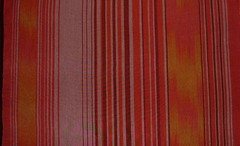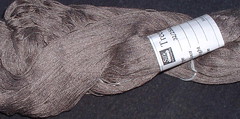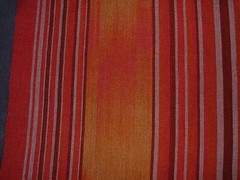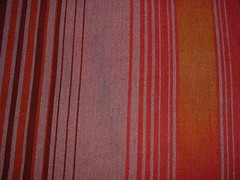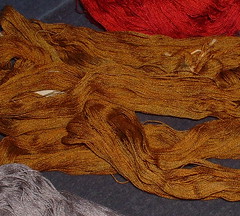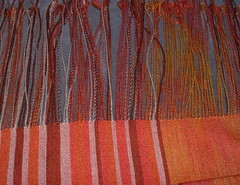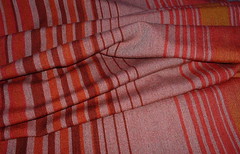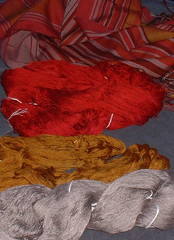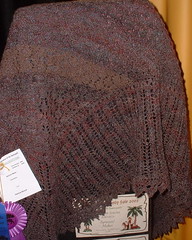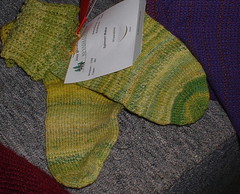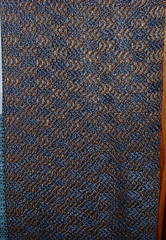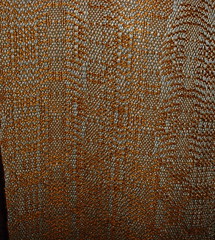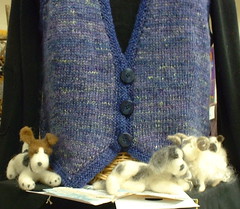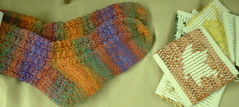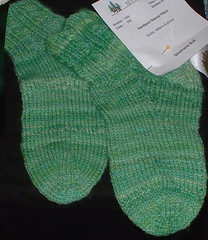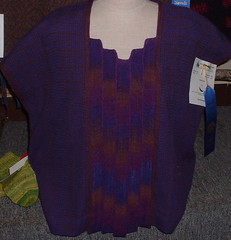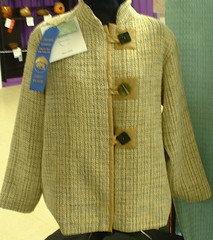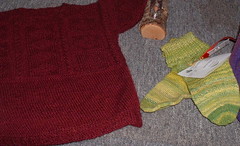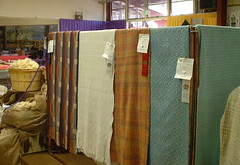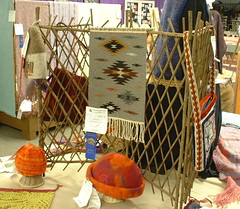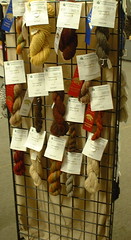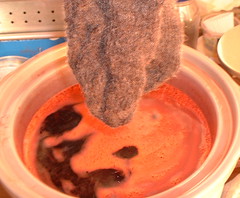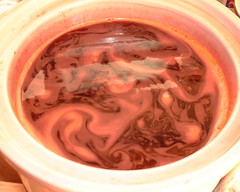That Gauge Issue
Yesterday was the SSK, and Patricia had this darling little sock she had knitted:
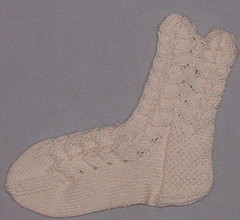
The trouble was, it was too small. She had done a gauge swatch, but not in pattern, and not using DPN's like she would eventually do for the sock. She used straights, in stockinette, and measured and calculated from there.
You see the problem. The green sock is her real sock size, the white one? Not so much:
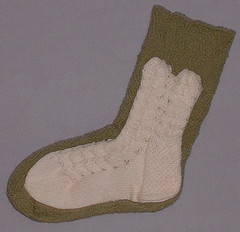
Ahem.
Well.
So then Sue and I had a confession.
We'll start at the beginning: A few months ago, Sue, Lindsey and I went to a few not-so-local yarn shops and then to lunch. The yarn shops were interesting. I am not a yarn buyer (I am a yarn spinner) but I like patterns, books and tools. I found small DPNs, a book or two, and an older copy of Interweave Knits (Winter 2005).
On page 20 of said magazine, there is a pattern for Mowat Mukluks, designed by Jennifer Appleby. We saw a pair of them knit up as a sample in the not-so-local yarn shop, and we all three thought they'd be fun to knit and wear.
Now, here is where that not-so-much-a yarn buyer issue crops up. I don't buy yarn, I barely look at it in the stores. Since I spin yarn, I consider a pattern a starting point, and adjust, if need be, my knitting to my yarn. Now in recent years, I've been knitting lace shawls. No real gauge issue: use whatever yarn and needles, and the finished size is what it is.
[cue the scary music here] I did not know what Plymouth Galway yarn was, but these were to be felted, so any old yarn would do, right?
I cast on merrily, having measured my foot and determined I would need the large size [music warning of impending disaster].
Sue came by to drop something off as I was part way into the first boot. Thinking it looked interesting, she volunteered to knit the second boot. We once knitted a pair of booties:
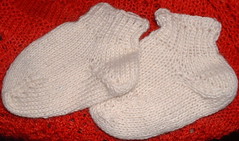
felted, dyed and gave them to charity:
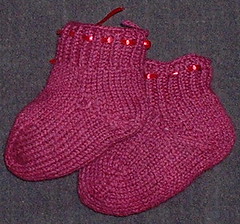
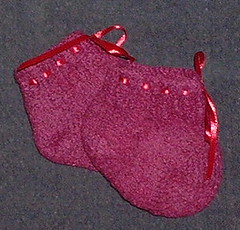
These were knit a year ago, on the cruise, as a sample of toe up socks from Joan Michael-McGowan's class. We know our gauge is different because the booties were somewhat different sizes, but we thought we could work this out [ominous music again].
We knitted. At one point Sue said "Why did you choose the large size?" [cue music]. Yes, these were getting big. We ran out of the yarn I started with, so we added other yarns. Now they were looking decidedly, um, colorful. We determined we would overdye them before felting, thus blending all the colors. We decided that if they turned out well, even if they didn't fit either of us, we would donate them to the auction at SOAR. They would fit somebody.
We pressed on. It became a mild obsession. Days passed. There was much laughter, several meals, eventually wine. Sue (she of the tighter gauge) finished hers and we weighed and measured prior to felting: foot = 20", diameter at upper cuff = 22", instep from leg to toe = 11" weight = 14 ounces.
I, of the looser variety, eventually finished, weighed and measured: foot = 22", diameter at upper cuff = 28", instep from leg to toe = 13", weight 1 pound 1.8 ounces.
Does anyone see a problem here? Also, these were ugly, with a capital U. They were yarnivores: almost two whole pounds of odd lot yarns used up:
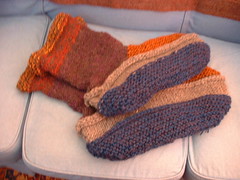
For scale: the cushion on the couch is 21" by 22".
Next, into the dyepot they went (navy, covers a multitude of sins, and slippers should be dark colors). Then into the washer they went. Hmmm. That gauge issue: two decidedly different sizes. Wash again, and dry them. Hmmm:
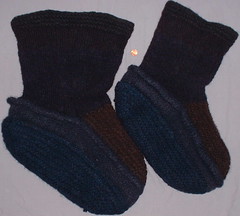
Yes, that is a penny for scale. Apparently they make a good cat bed:
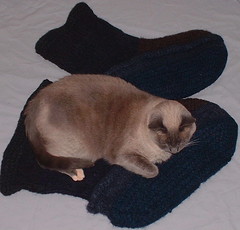
Hagrid's Boots. I think not for the auction after all. Anyone know how to get in touch with Hagrid? Sometimes you just have to laugh.
We move on. I will head to a commercial laundromat and try their very hot water, harder agitation, and hot dryer. I don't think it will erase all sins, but I want to try. One must try.
I stopped by my actual LYS to see what Plymouth Galway really was, and may try a new pair. Not using Plymouth Galway of course, but more leftover yarn. Now that I know the size of yarn to use. Perhaps I could do a gauge swatch?
And maybe I'll knit the small size next time. Or maybe I should make a gauge swatch?

The trouble was, it was too small. She had done a gauge swatch, but not in pattern, and not using DPN's like she would eventually do for the sock. She used straights, in stockinette, and measured and calculated from there.
You see the problem. The green sock is her real sock size, the white one? Not so much:

Ahem.
Well.
So then Sue and I had a confession.
We'll start at the beginning: A few months ago, Sue, Lindsey and I went to a few not-so-local yarn shops and then to lunch. The yarn shops were interesting. I am not a yarn buyer (I am a yarn spinner) but I like patterns, books and tools. I found small DPNs, a book or two, and an older copy of Interweave Knits (Winter 2005).
On page 20 of said magazine, there is a pattern for Mowat Mukluks, designed by Jennifer Appleby. We saw a pair of them knit up as a sample in the not-so-local yarn shop, and we all three thought they'd be fun to knit and wear.
Now, here is where that not-so-much-a yarn buyer issue crops up. I don't buy yarn, I barely look at it in the stores. Since I spin yarn, I consider a pattern a starting point, and adjust, if need be, my knitting to my yarn. Now in recent years, I've been knitting lace shawls. No real gauge issue: use whatever yarn and needles, and the finished size is what it is.
[cue the scary music here] I did not know what Plymouth Galway yarn was, but these were to be felted, so any old yarn would do, right?
I cast on merrily, having measured my foot and determined I would need the large size [music warning of impending disaster].
Sue came by to drop something off as I was part way into the first boot. Thinking it looked interesting, she volunteered to knit the second boot. We once knitted a pair of booties:

felted, dyed and gave them to charity:


These were knit a year ago, on the cruise, as a sample of toe up socks from Joan Michael-McGowan's class. We know our gauge is different because the booties were somewhat different sizes, but we thought we could work this out [ominous music again].
We knitted. At one point Sue said "Why did you choose the large size?" [cue music]. Yes, these were getting big. We ran out of the yarn I started with, so we added other yarns. Now they were looking decidedly, um, colorful. We determined we would overdye them before felting, thus blending all the colors. We decided that if they turned out well, even if they didn't fit either of us, we would donate them to the auction at SOAR. They would fit somebody.
We pressed on. It became a mild obsession. Days passed. There was much laughter, several meals, eventually wine. Sue (she of the tighter gauge) finished hers and we weighed and measured prior to felting: foot = 20", diameter at upper cuff = 22", instep from leg to toe = 11" weight = 14 ounces.
I, of the looser variety, eventually finished, weighed and measured: foot = 22", diameter at upper cuff = 28", instep from leg to toe = 13", weight 1 pound 1.8 ounces.
Does anyone see a problem here? Also, these were ugly, with a capital U. They were yarnivores: almost two whole pounds of odd lot yarns used up:

For scale: the cushion on the couch is 21" by 22".
Next, into the dyepot they went (navy, covers a multitude of sins, and slippers should be dark colors). Then into the washer they went. Hmmm. That gauge issue: two decidedly different sizes. Wash again, and dry them. Hmmm:

Yes, that is a penny for scale. Apparently they make a good cat bed:

Hagrid's Boots. I think not for the auction after all. Anyone know how to get in touch with Hagrid? Sometimes you just have to laugh.
We move on. I will head to a commercial laundromat and try their very hot water, harder agitation, and hot dryer. I don't think it will erase all sins, but I want to try. One must try.
I stopped by my actual LYS to see what Plymouth Galway really was, and may try a new pair. Not using Plymouth Galway of course, but more leftover yarn. Now that I know the size of yarn to use. Perhaps I could do a gauge swatch?
And maybe I'll knit the small size next time. Or maybe I should make a gauge swatch?
